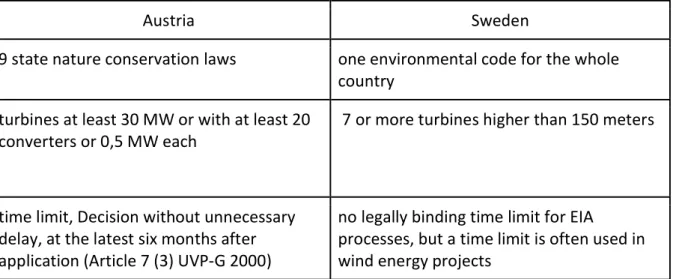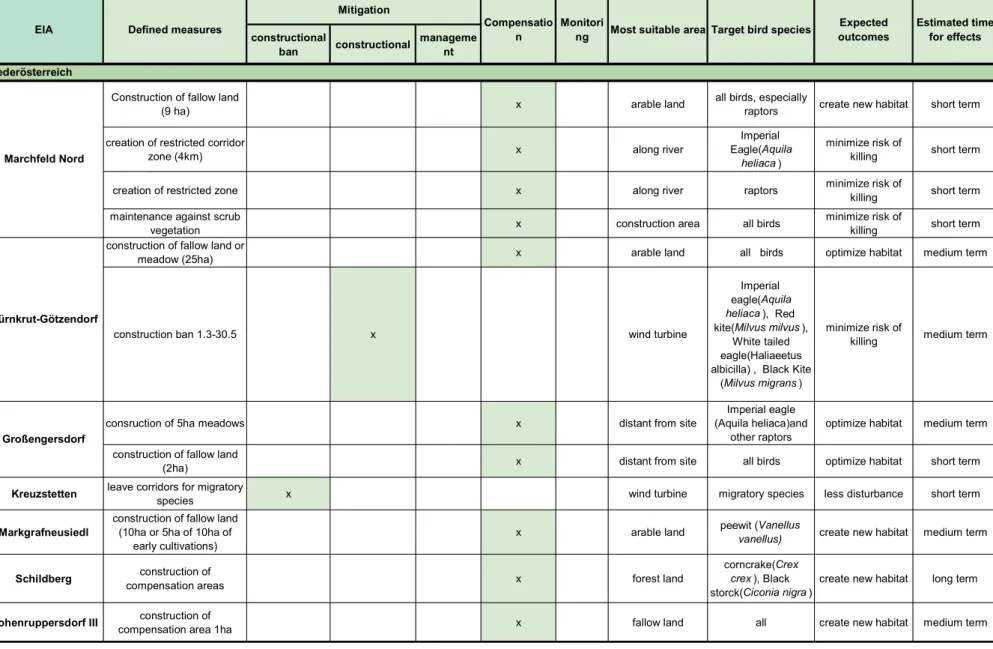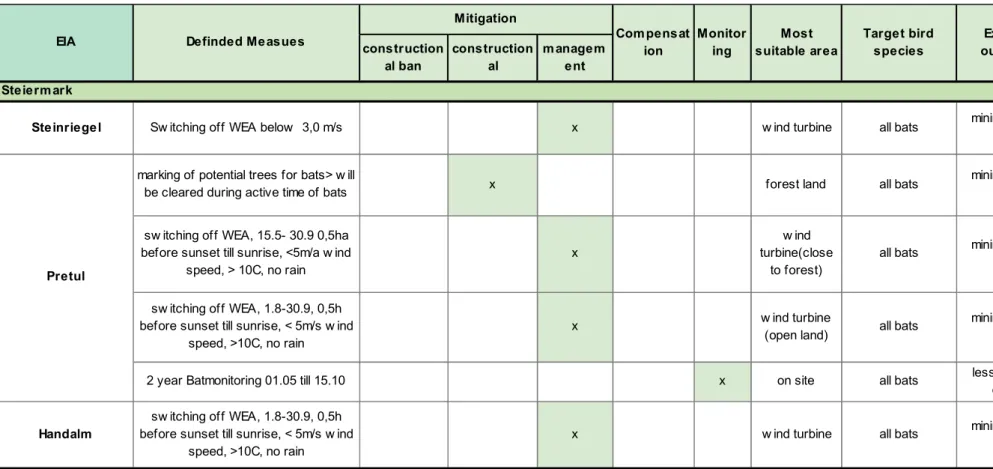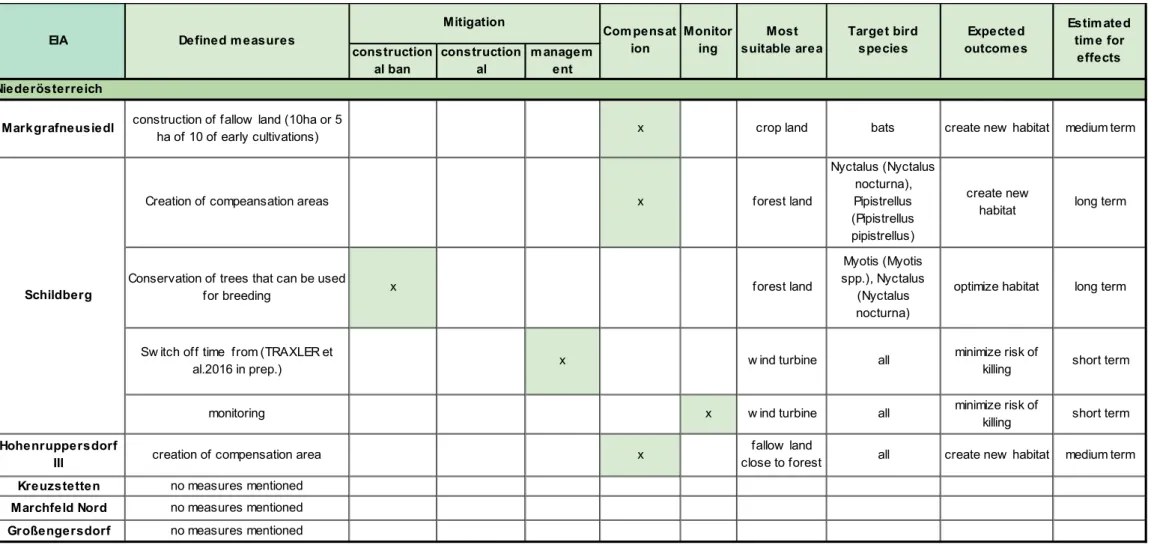53 Table 9: Analysis of the mitigation and compensation measures for birds in Austria, Lower Austria, Andresek, 2019. 62 Table 15: Analysis of the mitigation and compensation measures for birds in Kronoberg Län, Sweden, Andresek, 2019.

Climate Change and its impact on wind energy policies in Europe, Austria and Sweden
Firstly, we need to look at what Austria has achieved so far in terms of the use of wind energy. In the past two years, Sweden has increased its wind energy capacity by 1660 MW.
Wind energy production and its impacts on Land Use and Environmental Policies
The majority of wind energy is produced in the federal state of Burgenland, which has been energy self-sufficient since 2013 (Energie Burgenland, 2019). In Europe, the approval of the European Environmental Impact Assessment Directive in 1985 prompted the adoption of environmental impact assessment legislation in many European countries in the late 1980s (GLASSON et al., 2012, p. 40).
Legal bases of nature conservation law and protection requirements in the EU
The impact of wind energy production from wind turbines on bird and bat fauna
They face a number of threats from wind turbines, “impacts resulting from direct or indirect contact with moving turbine blades, causing fatal or sub-fatal injuries and barotrauma” (Schuster et al., 2015, p. 301). It is crucial to find the best possible solution to minimize the impact of wind turbines on bird and bat fauna (Baerwald et al., 2008, p. 1). coordinated coherently.
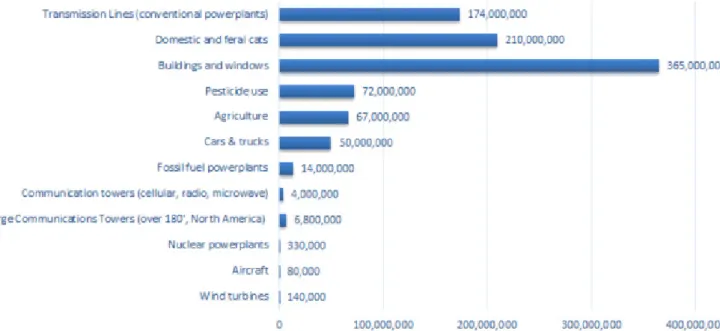
Wind energy and its conflicts with nature conservation of bird-fauna and bat-fauna . 14
This research focuses only on wind power generation with wind turbines used for onshore wind power generation. Since the beginning, the wind energy sector has developed, wind turbines have grown and the size of rotor blades has increased.
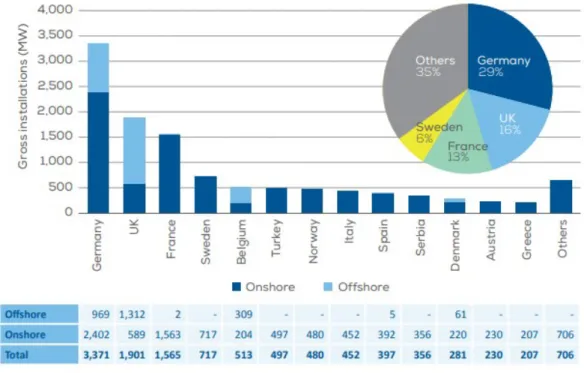
The impact of wind turbines on birds
Some species avoid turbines and areas more than others, and very specific behavior can be observed (Schuster et al., 2015).
The impact of wind turbines for energy production on bats
It shows species that are considered threatened at European level or listed in the EU Habitat Directive. Since the passage of the National Environmental Policy Act (NEPA) in the United States, environmental impact assessment systems have been established in various forms.
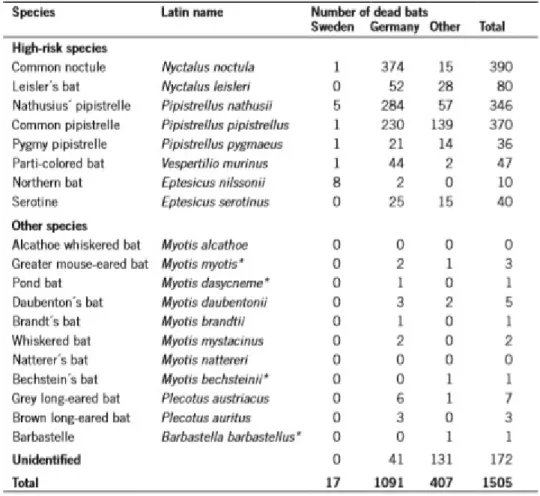
The Environmental Impact Assessment in the EU – The EIA Directive (EU Directive
Also, in the European Union the adoption of the European EIA Directive in 1985 stimulated the adoption of EIA legislation in many European countries in the late 1980s” (GLASSON et al., 2012, p. 40). But since "the meeting of the European Council in Cardiff in 1998, the issue of policy integration has been discussed, where.
Mitigation measures in the Environmental Impact Assessment
Mitigation and compensation measures in the EIA Directive (EU Directive 2011/92/EU)
There are some more detailed descriptions of mitigation measures in the current version of Directive 2011/92/EU in Article 5, which requires a description of the mitigation measure, and Article 9, which ensures that the public authority or authorities inform the public in accordance with appropriate procedures. If adverse impacts cannot be avoided, they must be reduced to an acceptable level through mitigation measures.
Main Alternatives
Compensation measures should only be implemented when all possible avoidance, reduction and compensation measures have been exhausted and significant and permanent impairments still remain. Other legislators, such as The United States, in its US Business and Biodiversity Offset Program, defines biodiversity offsets as "measurable conservation outcomes resulting from actions designed to offset significant residual negative impacts on biodiversity, after appropriate prevention and mitigation measures have been taken (Peste et al. ., 2014, p. 11).
The necessity of an EIA according to the EU directive
22 In the case of wind energy development, Sweden has introduced a well thought out spatial planning scheme for wind energy development which helps the operator to decide on a site for the projects as well as for possible alternatives. This sometimes makes it easier to find possible locations for wind energy projects and alternative projects.
The implementation of EIAs in Austria: Federal Act on Environmental Impact
The approval provisions in the respective Nature Protection Act must be included in the EIA's concentrated approval procedure. Its aim, set out in Article 1 of the Burgenland Nature Conservation and Landscape Management Act, is the protection and maintenance of nature and landscapes in all forms.
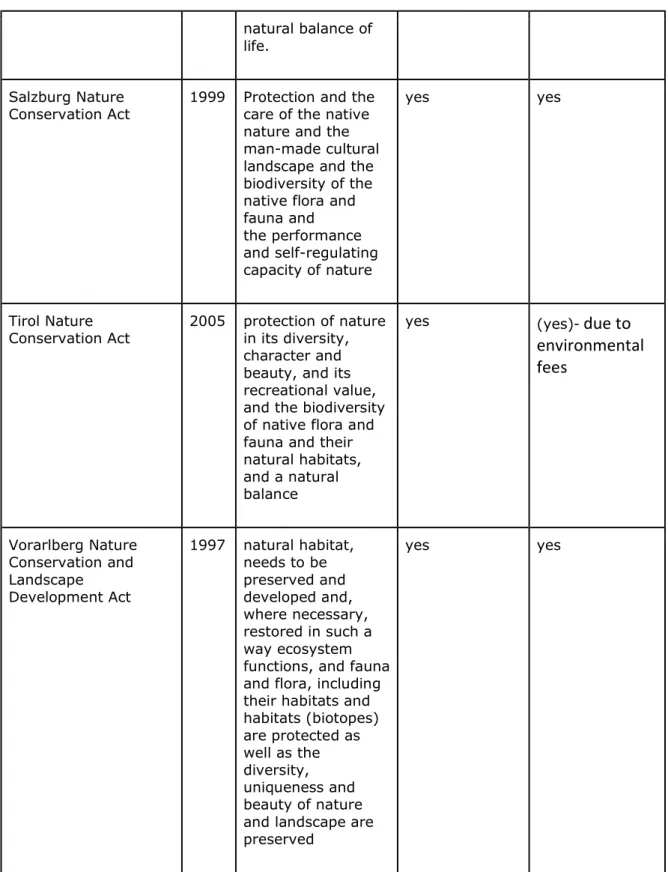
The EIA of wind parks in Austria
Characteristics of the project (size of the project, cumulation with other projects, use of natural resources, production of waste, environmental pollution and nuisances, risk of accidents). The EIA authority in whose federal state the largest part of the project is located is responsible.

The implementation in Sweden: Environmental Code (SFS 1998:808) and the Swedish
Another aim is to enable an overall assessment of this impact on human health and the environment. In relation to Chapter 6 Article 3 of the Ordinances, the purpose of the environmental impact assessment is to assess the direct and indirect impact of a planned activity or measure on people, animals, plants, soil, water, air, the climate, the landscape and the environment identify and describe. the cultural environment, on the management of land, water and the physical environment in general, and on other management of materials, raw materials and energy. Another aim is to enable an overall assessment of this impact on human health and the environment.
The necessity of an EIA for wind parks in Sweden
The purpose of an environmental impact assessment involving an activity that falls under the Measures to Prevent and Limit Environmental Impact Assessment Act. With regard to Chapter 20 of the Swedish Environmental Act, Chapter 2 states that the environmental courts are the first instance for hearing cases concerning. In addition, the code explains (Article 27) that if the effects of the activity cannot be predicted with sufficient certainty, the environmental court, when granting permission for the activity, may defer the issue of compensation or other conditions until information is available about the effects of the activity.
The process of EIA for Wind parks in Sweden
B For a wind energy installation for two or more turbines, where each turbine has a total height of more than 150 metres, permission must be requested from the provincial government (40.90). The application is always submitted for advice to the environmental committee of the municipality and to the provincial government as representative of public interests. At the same time, the district administration announces in the local press that the application with the EIA has been received.
Problem statement
Research Objectives & Hypothesis
Second, the literature on the effects of wind energy on bats and birds and the compensatory measures already in use was analysed. The environmental impact assessment includes planned mitigation and compensatory measures to avoid, reduce or compensate for significant adverse environmental impacts as written. Case study analysis will show the legal basis for mitigation and compensation measures and individual mitigation and compensation measures for birds and bats for each case study separately, as already used by Peste et al.
Selection of Case Studies
The implementation of the OSH Act was assessed through a survey of 30 case studies (see also Peste et. al 2014). The concept of working with case studies proved to be suitable for this thesis. The Swedish EIA case studies are located in the states of Jönjöping, Kronoberg and Skane in the south of Sweden.
Criteria for the case study selection
It is of great importance to the developer that the height of the wind turbine is as high as possible to be able to generate more energy from the turbine, as the winds are strongest at a height of more than 100 m above the ground. The rotor height is also selected as a criterion to see the variations of actual turbine height and rotor height. Therefore, wind farms have been chosen in plain, hilly and mountainous topography, to see the differences in the impacts on wildlife, as the fauna varies, between these three types of topography.
Research method to analyze mitigation and compensation in the EIA
Compensation: A compensatory measure implies that something must be constructed in the form of the compensatory measure. Some measures have a short-term effect, some a medium-term effect and some may need a little more time before effects become visible. Switch off hand alm WEA h before dusk to dawn, < 5m/s wind speed, >10C, no rain x wind turbineall bats minimize chance of short term deaths Compensation Monitoring Most suitable area Target bird species.
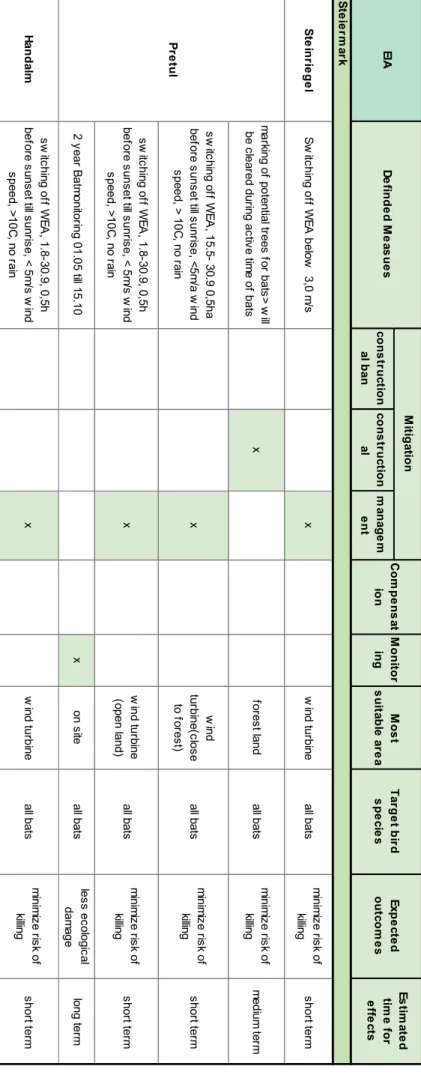
Differences between the Swedish and Austrian Procedure and legal base of the
The first avoidance is achieved through evidence of alternatives, and after this step the avoidance, compensation, and offset steps of the mitigation hierarchy are often discussed. Due to the difficulties in comparing data from EIA case studies, it is important to note how the data has been simplified into an understandable and comparable method. The second case study of the Swedish EIA and the third part discuss the similarities and contradictions between the Austrian and Swedish case studies.
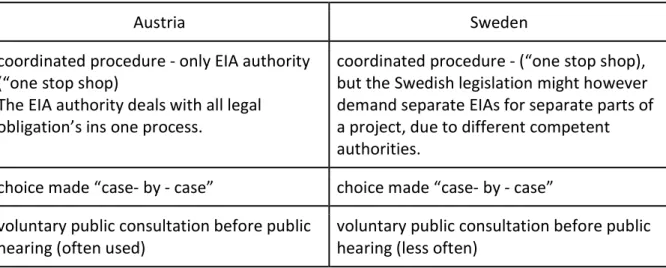
The Austrian EIA Case Studies
Create a compensatory area x distance from the location of the raider create a new habitat in the long term. ng Most suitable area Target bird species. Mowing ban x wind turbine for all birds optimizes habitat in the short term. close to each other x w wind turbine migratory species avoid disturbances in the short term. prohibition of building x in the hunting bird location. species avoid disturbances in the short term. Create a compensation area x w et area. medium-term growth site Prohibition of construction-. corridor x wet area migratory birds avoid disturbances in the short term. corridor x Along the road, migratory birds avoid disturbances in the short term.
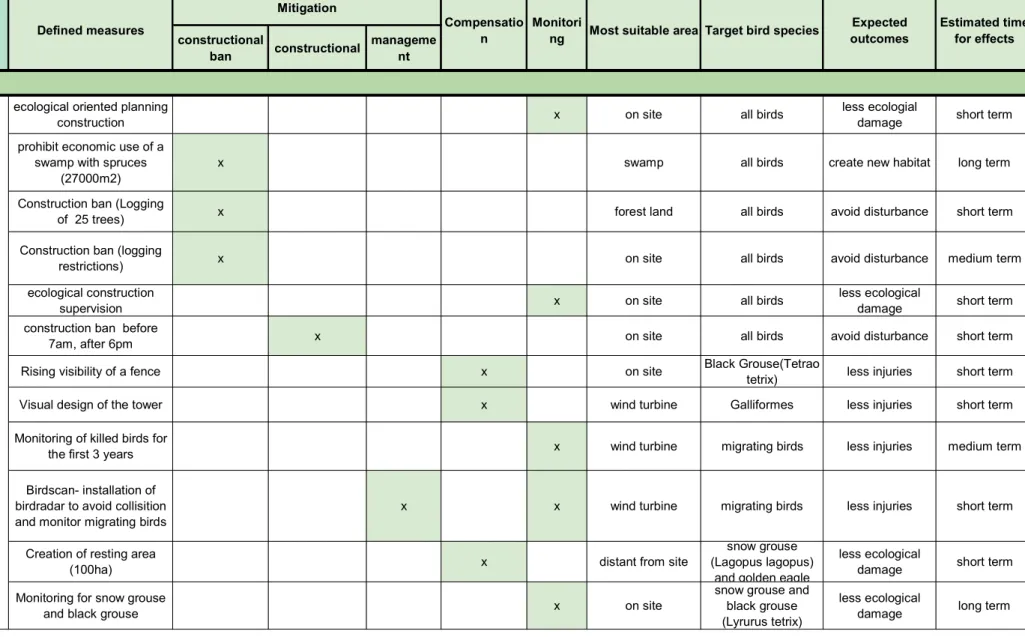
The Swedish EIA Case Studies
The outcome of the analyzes of Jönjöping's EIA case studies mainly show monitoring measures. To conclude with the Swedish EIA case studies, it means that there are differences in the amount of mitigation and compensatory measures and what type they use. The thesis shows that in particular the species of golden eagle (Aquila chrysaetos), osprey (Pandion haliaetus), imperial eagle (Aquila heliaca), white-tailed eagle (Haliaeetus albicilla), red kite (Milvus milvus), black kite (Milvus migrans), the red fried shrike (Lanius collurio), wood pipit (Anthus campestris), lapwing (Vanellus vanellus).
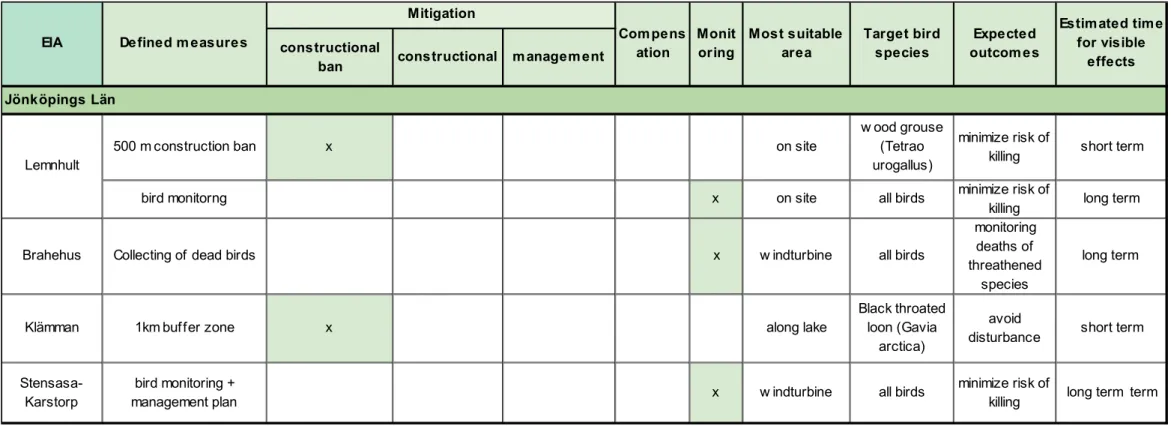
A Comparison of compensation measures of birds and bats in Austria and Sweden
The correlation coefficient of the size of the wind farm and the amount of measures for birds in Sweden is 0.224. The correlation coefficient of 0.006 for the EIA wind farms studied for the number of wind turbines and the number of measures for bats is significantly low. The correlation coefficient between the size of the wind farm and the amount of measures for birds in Austria is 0.171.
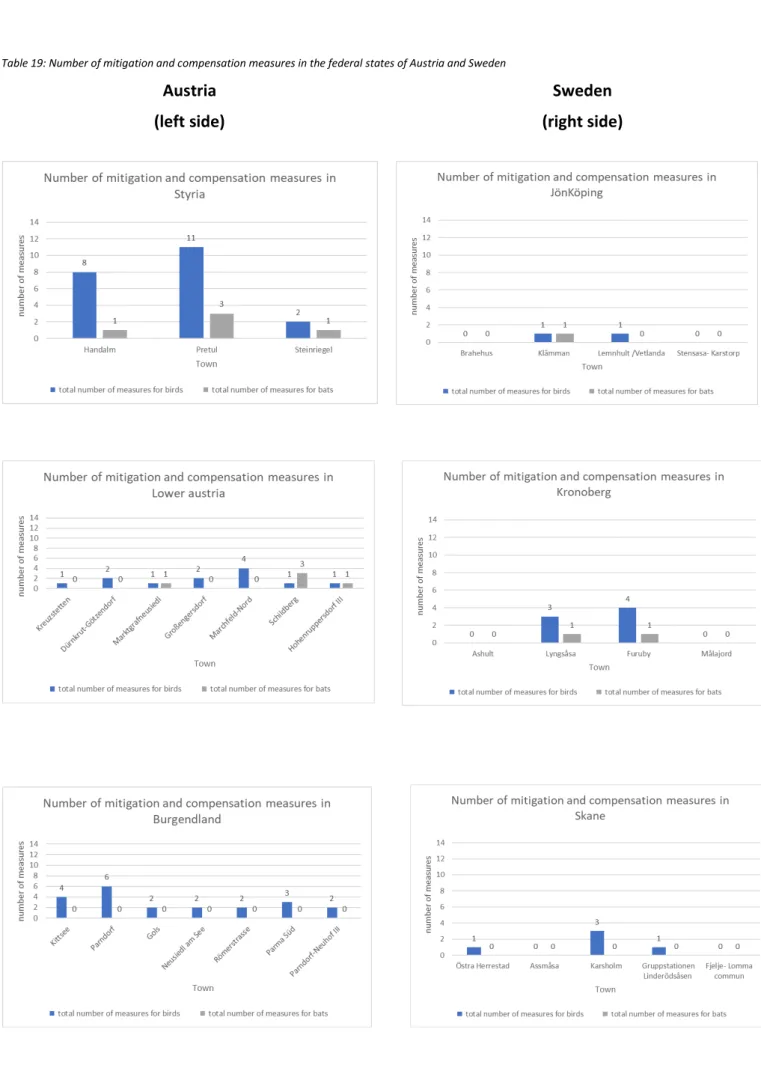
Methodological criticism
Analyses of the hypothesis
Styria has the most mitigation and compensation measures in two of the three case studies conducted in the Land of Styria in Austria. It follows from this that in the future measures for the protection of bats will probably be entered more regularly in the PVO. It says where the number of measures for birds is decreasing, such as in Lower Austria or in the federal state of Skane.
Current discourse in the field of Environmental Impact Assessments and relevance of
80 7.3.2 Monitoring of compensation areas after a certain period of time reclassification There is a public discourse in the field of Environmental Impact Studies and nature conservation on the subject of compensation areas and a reclassification of the spatial use after a certain period. The Austrian report on land consumption through compensation measures questions the purpose of the compensation measure. Most of the Austrian compensation measures are provided in arable land (Bundesministerium für Nachhaltigkeit und Tourismus, 2019 p 43).
Recommendation for action
As a rule, a very high potential for upgrading is foreseen, since it is possible to directly balance the damaged functions of the natural balance and, in addition, to restore the natural functions of the soil. Finally, there is no certainty as to what will happen to the compensation areas after the project is realized and completed. In this way, areas of high natural value can be taken into account in the long term and formalized into a spatial plan.
Summary
Inconsistencies in detail in the description of mitigation and compensatory measures were found. It has also been noted that the depth in detail of mitigation and compensatory measures increases over time in the case of bats. This may lead to more stability in the EIA process and the advanced implementation of mitigation and compensatory measures for birds and bats in the future.

